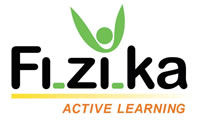 GET
UP, GET MOVING, AND GET LEARNING!
Exciting Resources Help Teachers Promote Active Learning
written by Deborah
Fast, Fizika
Group
"We need to show kids it's important to get active,"
says Sue Massucci, principal of Holland Elementary School
in Taylor, Michigan. "Getting active will help them become
more physically fit, and will also make their brains more
active."
This conviction led Massucci to embrace the EPEC
curriculum (Exemplary
Physical Education Curriculum) and its complementary products
developed by the Michigan
Fitness Foundation that give teachers and administrators
the tools they need to foster "Active Learning"
in their schools. "I felt it would be wonderful,"
she says of the introduction at a principals' meeting in spring
2009. "Video games, television and so many things keep
kids sitting. They need to get up and get their bodies moving."
 An
Active Learning approach is based on the understanding, supported
by increasing research, that quality physical education as
well as physical activity in the classroom can play a significant
role in enhancing learning and improving students' academic
achievement. In a program called "PE-Nut" (physical
education and nutrition education working together) EPEC is
combined with classroom resources (i.e., Fit Bits and Healthy
Classrooms, Healthy Schools) in a whole-school approach, involving
physical educators, classroom teachers, students, administrators
and even parents. An
Active Learning approach is based on the understanding, supported
by increasing research, that quality physical education as
well as physical activity in the classroom can play a significant
role in enhancing learning and improving students' academic
achievement. In a program called "PE-Nut" (physical
education and nutrition education working together) EPEC is
combined with classroom resources (i.e., Fit Bits and Healthy
Classrooms, Healthy Schools) in a whole-school approach, involving
physical educators, classroom teachers, students, administrators
and even parents.
EPEC
itself is a standards based curriculum, with a strong assessment
component, geared to teach students lifelong skills. Fit
Bits are dynamic activity breaks for the classroom, infused
with nutrition and personal/social themes. The Healthy
Classrooms, Healthy Schools set of resources helps every
classroom become an environment where students can learn and
practice healthy eating and physical activity habits. HCHS
features healthy snack ideas and recipes, letters to families,
school-wide nutrition announcements and a support CD.
Adam Brown, PE teacher at Holland Elementary, is in his second
year of using the EPEC curriculum. Brown was actually introduced
to EPEC while studying at university, where professors encouraged
him to take a look at the curriculum. "It's very appealing
for a new teacher; you couldn't ask for a better resource,"
explains Brown.
"EPEC is laid out with hundreds of lessons that are
developed by master PE teachers and mirror national standards
and benchmarks. The lessons are developmentally appropriate,
and are laid out in a way that a new teacher could open the
EPEC box on the first day of school and follow right along
the whole year. Each skill and activity comes with assessment
rubrics and step by step instructions with color posters and
a CD with animated demonstrations."
"EPEC aligns with my approach to PE," says Brown.
"I really focus on the acquisition of skills at an elementary
level so that the students are prepared moving forward with
their education. I have taught at the secondary level, and
they tend to focus more on
physical fitness and game play, so with a solid skill base
I feel my students will be well prepared. EPEC also comes
with assessment rubrics which has made tracking student progress
fairly easy, and allows me to change teaching techniques if
my
students are not progressing."
.jpg)
"While the EPEC curriculum includes a lot of information,
as well as complete lesson plans, it can also be used as a
supplement to existing lessons, providing detailed content
for a specific skill," says Brown. "EPEC is an outstanding
resource to brush up on skill breakdowns and for new lesson
ideas."
Brown also supports the use of Fit
Bits and Healthy
Classrooms, Healthy Schools by classroom teachers. "Daily
physical education combined with classroom activity will help
kids learn better, and have positive attitudes in the gym
and in the classroom. Diet is also so important; many students
don't have the energy they need to get through the day and
to be physically active. The Fit
Bits provide a nice break in the action for classroom
teachers, and HCHS helps infuse healthy nutrition practices
into the classroom.
Making Healthy Choices
Massucci points out that these resources, particularly Healthy
Classrooms, Healthy Schools, are teaching students to
make healthy choices. "We need to help kids see the reasons
for making these choices. And it carries over into their homes,"
she explains.
HCHS
promotes healthy snacks in the classroom, for example, "which
changes thought patterns," says Massucci. And she observes
changes in behavior in the cafeteria as well: "Kids are
trying new things, like broccoli and carrots with dip and
fresh fruit. It's positive peer pressure - which is better
received than Mom serving it!"
Massucci enthusiastically recommends EPEC and related resources
to other schools. "People fear the time constraints involved,"
she explains, "But I tell them, 'You need to fit this
into your program!'"
For more information about any of these resources, contact
us at info@fizikagroup.com
or visit our website at http://www.fizikagroup.com/
(back
to pelinks4u homepage) |





 An
Active Learning approach is based on the understanding, supported
by increasing research, that quality physical education as
well as physical activity in the classroom can play a significant
role in enhancing learning and improving students' academic
achievement. In a program called "PE-Nut" (physical
education and nutrition education working together) EPEC is
combined with classroom resources (i.e., Fit Bits and Healthy
Classrooms, Healthy Schools) in a whole-school approach, involving
physical educators, classroom teachers, students, administrators
and even parents.
An
Active Learning approach is based on the understanding, supported
by increasing research, that quality physical education as
well as physical activity in the classroom can play a significant
role in enhancing learning and improving students' academic
achievement. In a program called "PE-Nut" (physical
education and nutrition education working together) EPEC is
combined with classroom resources (i.e., Fit Bits and Healthy
Classrooms, Healthy Schools) in a whole-school approach, involving
physical educators, classroom teachers, students, administrators
and even parents..jpg)